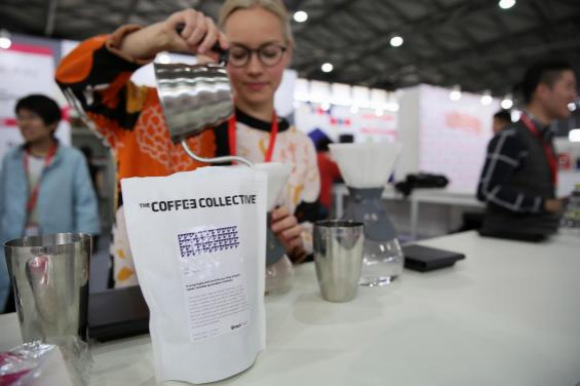Finns who drink 10 cups of coffee a day will soon become "coffee spirits".
English tea, Finnish coffee. At the beginning of this year, Finns were ranked as the world's top coffee consumers by the International Coffee Organization, citing up to 12 kilograms of coffee a year, compared with 2.8 kilograms in the United Kingdom and 5.8 kilograms in Italy. That's about 10 cups of coffee a day, usually hot, black coffee with a traditional Finnish cinnamon roll-which can also be literally translated as a "slapped ears" snack.
Such a stable coffee consumption requires both coffee breaks and people who continue to provide coffee. "it usually takes a few drinks to visit relatives and friends," said Samuli Ronkanen, owner of the Good Life Cafe in Helsinki. "No matter how many cups of coffee you have drunk before, it is impolite not to enjoy the coffee and pastries provided."
This is a complete profit for Ronkanen, because his coffee beans are available all over the city, and his coffee shops in the Kallio community are usually packed with people, savoring a well-brewed latte and a sweet almond croissant. "it's been cold and dark for most of this year, and we all need something to stay healthy and warm," he explained. " He tried to justify a large amount of caffeine intake. Benjamin Andberg, who runs Helsinki Kahvipaahtimo (Helsinki Coffee Roasters), is even more used to this phenomenon. "Finns like coffee very much because you can't drink all the time," he said.
Mikaela Gervard, the winner of the 2015 and 2016 Finnish hand Coffee Competition (Brewers Cup), who finished second at the 2016 World Championships, said: "We always have a chance to drink coffee." She also pointed out that there is a law for drinking coffee in Finland: "according to the law, we have two 10-minute coffee breaks a day."

Mikaela Gervard is a celebrity in the hand coffee contest. Photo Source: Cai Yuanyuan
Until recently, however, there was no guarantee that Finns drinking 10 cups of coffee a day was beneficial. Svante Hampf, who runs Kaffa Roastery in Helsinki, said: "Finland is famous for per capita coffee consumption, not for drinking quality coffee." When he was at school, he wanted to find a job in a good cafe, but he never liked to drink the coffee provided by those shops. "We can't find good coffee anywhere in Finland," he explained. "so we started making quality coffee for ourselves."
Now, Hampf,Ronkanen and Andberg are a group of committed entrepreneurs and some members of coffee-driven dreamers who are committed to improving coffee in Helsinki: one cup at a time-while promoting the revival of urban cuisine. "this is Finland, which drinks the most coffee in the world, isn't it a good place to run a coffee company?" Andberg said. All three companies focus on business ethics, sustainability and coffee quality, which are three characteristics that many Finns expect from the coffee and food they enjoy. "it's a good place to run a coffee company, especially when people focus on new and exciting things," Hampf said. " In terms of culinary culture, Finland is on the right track and is expected to catch up with or even surpass its Nordic neighbours, led by young fashion pioneers, combining local elements, sustainable goals and unusual ingredients such as reindeer and vegetarian meat. "

Finland has the highest per capita coffee consumption in the world. Photo Source: Good Life
In Helsinki, the so-called "third Wave Cafe" (third-wave coffee shops)-coffee shops that measure ground coffee beans on scales and use digital timers can be found everywhere. For example, in the design area (Design District), there is a chic white-wall cafe, Kuuma;, built in a container at sea, and Ihana Kahvila;, which opens only in the summer, and the well-lit Maja coffee roaster near the Alva Aalto Museum (and, of course, Good Life Caf é). This is part of an innovative cooking scene that, driven by local trends, is more plant-based and moves towards dazzling boundaries. (if you don't believe that coffee can innovate, try Date & Kale' s, which pours oatmeal milk, cocoa and butter into espresso.)
However, coffee has long been a part of Finnish culture, dating back to before Finland's independence, and this year coincides with the 100th anniversary of Finland's independence. "Finns are usually looking for brands that are reliable, sustainable and trustworthy," Hampf said. "in the long run, it is not the pursuit of flashy, but the hope of winning trust."
While young companies are trying to hone their coffee qualifications, others have cemented their reputations: Karl Fazer, a cafe and candy shop built in 1891, and the maker of Salmiakki, a Finnish specialty salty licorice sugar that is beloved and annoying, now serves good coffee. Ekberg, Finland's oldest restaurant, has served coffee and pastries since 1852-but now they use organic, sustainably grown Arabica coffee beans that complement their more than 150-year-old Champagne Cork pastries.
Although the "third wave of coffee" is now all the rage, Finnish roasters are more focused on long-term development, hoping to permanently improve Finns' greedy coffee-drinking habits. "what will happen in the next 10 years? No one knows, "Hampf said. "but we'll still be here, baking the best beans we can find."
Important Notice :
前街咖啡 FrontStreet Coffee has moved to new addredd:
FrontStreet Coffee Address: 315,Donghua East Road,GuangZhou
Tel:020 38364473
- Prev

"New Yorker" in Yunnan
In the novel Lost Horizon by British writer James Hilton, four western tourists break into the mysterious Shangri-La and experience a series of incredible events. This book has achieved the legendary Shangri-La, the paradise in everyone's heart. In 2003, three New Yorkers also came to Yunnan, and when they saw the sacred snow mountains, deep valleys, and flying
- Next

Internet cafes become "Internet cafes", but it is not as simple as providing coffee service.
When it comes to Internet cafes, many people's impression of them may still stay in a dark, smoky, bad place full of Internet addicted teenagers and idle people in society. Nowadays, in first-and second-tier cities such as Beijing, Shanghai, Guangzhou and Shenzhen, it is rare to see the signs of Internet cafes. It is not that Internet cafes are gone, but they are quietly reinvented in the form of Internet cafes. According to chopsticks play thinking (ID:kwthink)
Related
- What ratio of water temperature and ground does the smart cup method use to press coffee? The difference between brewed coffee and filtered coffee?
- What is the standard process for the purpose of coffee cup testing? What is the difference between hand-brewed coffee and cup testing?
- How to use hand-brewed coffee paragon small golden balls? How does cold coffee lock in the aroma of coffee?
- Is American coffee black? What is the difference between American coffee and drip coffee?
- Unexpected! Well-known tea beverage brand Lele Tea will withdraw from the Zhengzhou market!
- Starbucks enters the fashion and beauty industry?! Netizen: Give me an ice American eye cream
- Why can American refills for free? The difference between Americano and American drip pot coffee
- Being chased out of the rain in front of Starbucks?! Store: Sheltering from rain under umbrellas poses a safety hazard
- The white moonlight has changed?! Lucky launches "Big Winter Pear American"
- Hand-brewed coffee three-stage method, high-sweet and universal brewing method to share! What does the high sweet water level of hand-brewed coffee mean?

